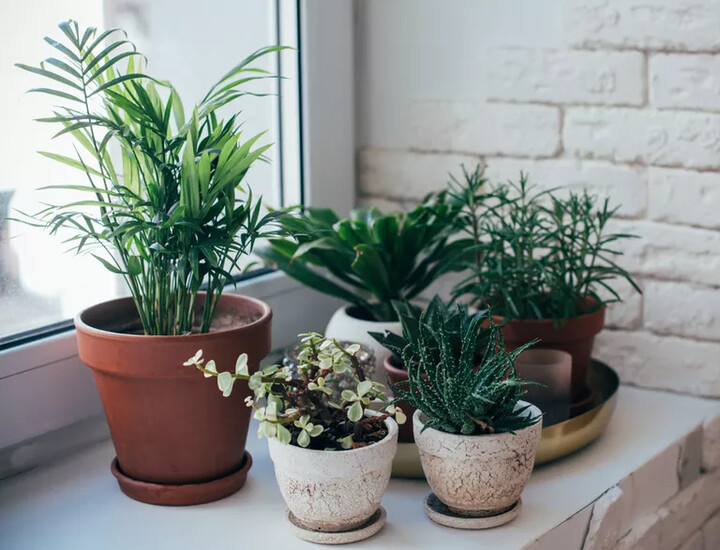Colder weather provides some unique challenges for indoor plants; here's how to how to help them get through it.

If you bemoan winter's cold drafts, the Sahara blasts from too-hot heaters, and the sun setting in the middle of the afternoon, just think how houseplants feel. It's not like they can grab a sweater, drink mulled wine, and sit in front of a light to fend off winter woes on their own – they need a bit of help from their caregivers.
Where to start? With plant guru Maryah Greene of Greene Piece plant consulting, of course. Greene has collaborated with Love Home and Planet to come up with a slew of suggestions for the cooler months, of which we have included in the tips below.
1. Prune, prune, PRUNE
"The best thing you can do for your plants when they feel the effects of winter is to cut or pull off any browning or yellowing leaves," say Greene. "Pruning not only makes your plant look healthier, but it also encourages new growth in the plant by preventing it from channeling so much energy into dying leaves."
2. Mind the windows
Many of us give our plants that prime real estate space known as the windowsill. But as Greene points out, this can be a particularly drafty spot. If that’s the case, she advises "to move your plant away from the window while also making an effort to ensure that it gets similar amounts of light in its new location. In order to maximize the amount of sunlight coming through your windows, make it a habit to wipe down your windows." She recommends using Love Home and Planet’s Multi Purpose Surface Spray and doing it either on watering day, or at least once a month to incorporate it into an already existing routine.
3. Watch the watering
A plant's summer and winter watering needs may be very different, and you may need to adjust watering frequency. For instance, says Greene, "if you’re watering your Pothos once per week throughout the year but find that you’re blasting your heater in the winter, you might notice the water evaporating at a much quicker rate and your Pothos plant might benefit from watering every 5 days instead of once per week." Meanwhile, I have found that many of my plants like less frequent watering since their growth rate is slower – the bottom line is to pay attention to each plant and treat it accordingly.
4. Let there be light
Just like people can feel the effects of winter's short days, so can your plants. And just like people can use a therapy light to feel better, so can your plants benefit from a grow light to supplement light during the darker days. Look for any “Full Spectrum LED” grow light, says Greene. "One of my favorites is produced by Soltech Solutions – they offer a range of sizes and colors and I love that their light isn’t purple or yellow like most other options. I also keep my grow light on a timer to match the amount of sunlight that my plants receive on a daily basis."
5. Beware of winter plant sales
As the weather cools, houseplants – just like their outdoor friends – start shedding their leaves and falling asleep for the winter. "Plant shops know this, and may have difficulty getting their plants off of the shelf before they start to show signs of sadness or declining health," says Greene. "That being said, be wary of 'Plant Sales' because you might make the mistake of taking home a plant that’s the most difficult to care for during this cold winter months." Greene suggests asking questions at the nursery to get a better idea of how to care for your plant before bringing it home.
6. And, the miscellaneous
Lastly, some things I have learned over the years:
Watch humidity levels if your home has dry heat, which can lower the relative humidity to 10 to 20 percent; most plants like it between 40 to 60 percent.
Move plants away from hot spots near heaters; and if windows aren't drafty, move them closer to get more light. But if there is a big temperature swing between day and night on the windowsill, don't put them there.
Watch the fertilizer: Some plants do not need any fertilizer at all during winter. I recommend researching which plants need what in terms of food until spring returns.
If you want to repot, wait until spring.